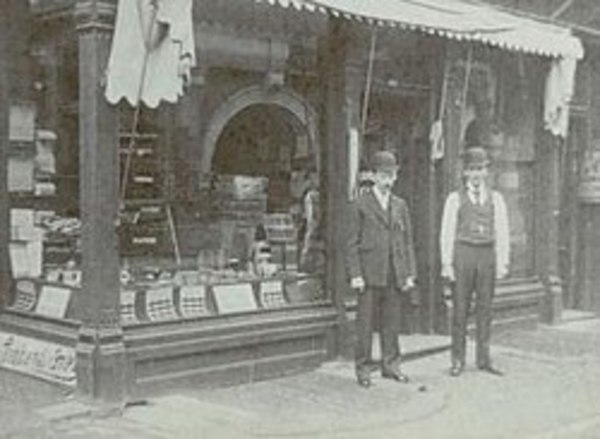
Source: Link
GRAND, JAMES, businessman; b. 8 March 1857 in Yorkville (Toronto), son of James Grand, an architect, and Mary Ann — ; m. 8 March 1881 Elizabeth Jane Toy in Toronto, and they had three sons; d. there 7 Nov. 1921.
A co-founder of one of Canada’s most successful stationery firms, James Grand was raised in Toronto by English-born Anglican parents. In the mid 1870s he was a clerk and salesman, possibly in the stationery business of his brother-in-law William Leitch MacGillivray. Between 1878 and 1882 Grand and Frederick Perry worked in partnership as printers and railway and mercantile stationers, after which Grand continued under his own name. Failing prospects, combined with responsibility for his wife and son, may have pushed him to tackle a new enterprise, though he was already fighting a serious illness (possibly scleroderma, which would eventually force his retirement). On 1 Aug. 1882 he opened a stationery supply firm on King Street. Grand found that Toronto’s market was eager for a personal touch, which he provided by delivering goods right to the customer’s door in a wheelbarrow. Business prospered so much that one year later, on 1 Aug. 1883, he signed a partnership agreement with Samuel Martin Toy, his brother-in-law and a bookkeeper, to form Grand and Toy, with a store at the corner of Leader Lane and Colborne Street.
Grand soon realized that businesses required not only paper goods but also a complete range of office supplies, including typewriting materials. The company thus expanded, and a new store was opened in August 1893 at Wellington and Jordan. Although Grand and Toy gained a name for quality products (its slogan from 1883 to 1990 was “If Its Good – We Have It”), the firm did not have a large customer base. In 1904 Toronto had over 20 stationery and office-supply concerns in the downtown area. The company’s fortunes, however, changed almost overnight. On 19–20 April 1904 fire devastated the city’s commercial core. Over 220 businesses were destroyed, including 23 printing, bookbinding, and lithographing concerns, among them Warwick Brothers and Rutter, W. J. Gage, Barber and Ellis, and Copp, Clark. “The stationery trade of Canada is ruined,” Arthur Frederick Rutter ruefully told the Globe. By luck of location (one block east of the flames) and favourable winds, as well as the quick work of Grand’s eldest son, Percy Frank, dousing sparks on the roof of their warehouse and store, Grand and Toy survived. In the aftermath of the fire, many businesses required a full stock of stationery and supplies. Grand and Toy was ready. Its sales were so intense during the rebuilding process that the partners handed out waste-paper baskets so that customers could fill their own orders. Heretofore grocers were the only merchants likely to have allowed any type of self-service.
The company expanded its clientele enormously over the following decade. Toy’s death on 1 March 1906 left the firm under the sole control of the Grand family, who would run it until 1990. In 1911 James Grand had it incorporated and he opened an office-furniture department. In addition, to complement his profusely illustrated catalogues, he initiated Office Talk, a monthly promotional bulletin for his clients and employees. Within its pages, he demonstrated his sound knowledge of ethical business principles and offered futuristic articles on Toronto’s need for an underground electric transit system, the transmission of business news by radio, and the place of ergonomics in the design of office equipment.
Grand continued as the titular president of Grand and Toy Limited until his death, though his poor health had caused him virtually to retire in 1913, when his son Percy, then vice-president, took over. Little is known of James Grand’s private interests; by 1901 he and his wife had converted to Methodism. He died in 1921 at his residence at 28 Oriole Road, in the Deer Park neighbourhood, and was interred in St James’ Cemetery. His estate, most of it in life insurance and stock, was valued at more than $210,500.
AO, RG 22-305, no.44063; RG 80-5-0-104, no.13529; RG 80-8-0-804, no.6603. LAC, RG 31, C1, 1871, Toronto, St James’ Ward, div.6: 75; 1901, Toronto, Ward 4, div.5: 9 (mfm. at AO). Globe, 2 March 1906, 8 Nov. 1921. Grand and Toy Limited, Grand & Toy Limited: a century of service, 1882–1982 ([Toronto, 1982?]; copy in North York Central Library (Toronto), Canadiana Coll.); Mail order catalogue of office supplies, printing and office furniture (Toronto), 1924 (copy in TRL, SC). Michael McVean, 100 years for Grand & Toy Ltd., an all-Canadian celebration of success ([Toronto, 1982?]; copy in North York Central Library, Canadiana Coll.). Nancy Rawson and Richard Tatton, The great Toronto fire (Erin, Ont., 1984).
Cite This Article
Gayle M. Comeau, “GRAND, JAMES,” in Dictionary of Canadian Biography, vol. 15, University of Toronto/Université Laval, 2003–, accessed November 28, 2024, http://www.biographi.ca/en/bio/grand_james_15E.html.
The citation above shows the format for footnotes and endnotes according to the Chicago manual of style (16th edition). Information to be used in other citation formats:
| Permalink: | http://www.biographi.ca/en/bio/grand_james_15E.html |
| Author of Article: | Gayle M. Comeau |
| Title of Article: | GRAND, JAMES |
| Publication Name: | Dictionary of Canadian Biography, vol. 15 |
| Publisher: | University of Toronto/Université Laval |
| Year of publication: | 2005 |
| Year of revision: | 2005 |
| Access Date: | November 28, 2024 |



